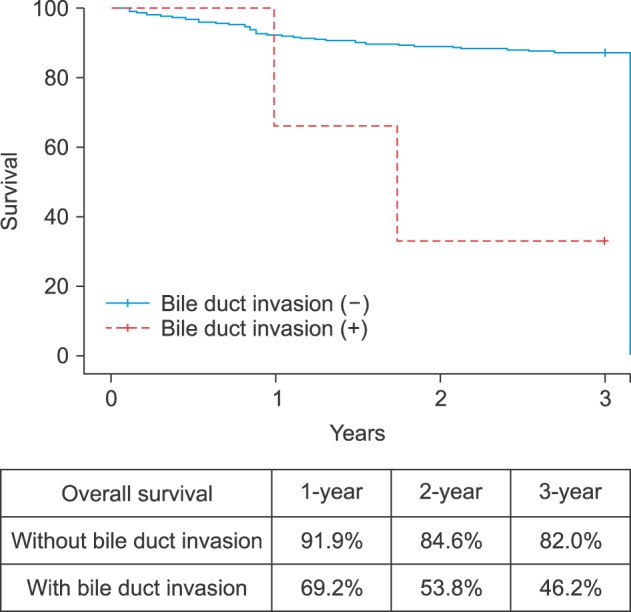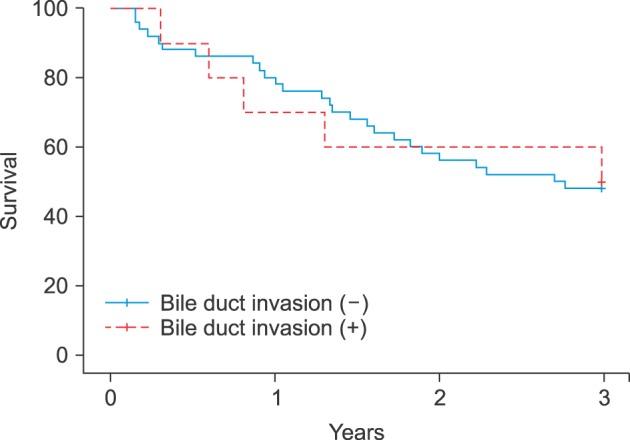Korean J Hepatobiliary Pancreat Surg.
2015 Nov;19(4):167-172. 10.14701/kjhbps.2015.19.4.167.
Bile duct invasion can be an independent prognostic factor in early stage hepatocellular carcinoma
- Affiliations
-
- 1Department of Surgery, Seoul National University College of Medicine, Seoul, Korea. Kwleegs@gmail.com
- KMID: 2130969
- DOI: http://doi.org/10.14701/kjhbps.2015.19.4.167
Abstract
- BACKGROUNDS/AIMS
In hepatocellular carcinoma (HCC), bile duct invasion occurs far more rarely than vascular invasion and is not well characterized. In addition, the pathologic finding of bile duct invasion is not considered an independent prognostic factor for HCC following surgery. In this study, we determined the characteristics of HCC with bile duct invasion, and assessed the clinical significance of bile duct invasion.
METHODS
We retrospectively reviewed the medical records of 363 patients who underwent hepatic resection for HCC at Seoul National University Hospital (SNUH) from January 2009 to December 2011. Preoperative, operative, and pathological data were collected. The risk factors for recurrence and survival were analyzed. Subsequently, the patients were divided into 2 groups according to disease stage (American Joint Committee on Cancer/International Union Against Cancer 7th edition): early stage (T1 and 2) and advanced stage (T3 and 4) group; and risk factors in the sub-groups were analyzed.
RESULTS
Among 363 patients, 13 showed bile duct invasion on pathology. Patients with bile duct invasion had higher preoperative total bilirubin levels, greater microvascular invasion, and a higher death rate than those without bile duct invasion. In multivariate analysis, bile duct invasion was not an independent prognostic factor for survival for the entire cohort, but, was an independent prognostic factor for early stage.
CONCLUSIONS
Bile duct invasion accompanied microvascular invasion in most cases, and could be used as an independent prognostic factor for survival especially in early stage HCC (T1 and T2).
MeSH Terms
Figure
Reference
-
1. Kasai Y, Hatano E, Seo S, Taura K, Yasuchika K, Uemoto S. Hepatocellular carcinoma with bile duct tumor thrombus: surgical outcomes and the prognostic impact of concomitant major vascular invasion. World J Surg. 2015; 39:1485–1493. PMID: 25651961.
Article2. Edge SB, Compton CC. The American Joint Committee on Cancer: the 7th edition of the AJCC cancer staging manual and the future of TNM. Ann Surg Oncol. 2010; 17:1471–1474. PMID: 20180029.
Article3. Ikenaga N, Chijiiwa K, Otani K, Ohuchida J, Uchiyama S, Kondo K. Clinicopathologic characteristics of hepatocellular carcinoma with bile duct invasion. J Gastrointest Surg. 2009; 13:492–497. PMID: 19011945.
Article4. Zeng H, Xu LB, Wen JM, Zhang R, Zhu MS, Shi XD, et al. Hepatocellular carcinoma with bile duct tumor thrombus: a clinicopathological analysis of factors predictive of recurrence and outcome after surgery. Medicine (Baltimore). 2015; 94:e364. PMID: 25569656.5. Satoh S, Ikai I, Honda G, Okabe H, Takeyama O, Yamamoto Y, et al. Clinicopathologic evaluation of hepatocellular carcinoma with bile duct thrombi. Surgery. 2000; 128:779–783. PMID: 11056440.
Article6. Shiomi M, Kamiya J, Nagino M, Uesaka K, Sano T, Hayakawa N, et al. Hepatocellular carcinoma with biliary tumor thrombi: aggressive operative approach after appropriate preoperative management. Surgery. 2001; 129:692–698. PMID: 11391367.
Article7. Kojiro M, Kawabata K, Kawano Y, Shirai F, Takemoto N, Nakashima T. Hepatocellular carcinoma presenting as intrabile duct tumor growth: a clinicopathologic study of 24 cases. Cancer. 1982; 49:2144–2147. PMID: 6280834.
Article8. Yeh CN, Jan YY, Lee WC, Chen MF. Hepatic resection for hepatocellular carcinoma with obstructive jaundice due to biliary tumor thrombi. World J Surg. 2004; 28:471–475. PMID: 15085398.
Article9. Lau W, Leung K, Leung TW, Liew CT, Chan MS, Yu SC, et al. A logical approach to hepatocellular carcinoma presenting with jaundice. Ann Surg. 1997; 225:281–285. PMID: 9060584.
Article10. Qin LX, Ma ZC, Wu ZQ, Fan J, Zhou XD, Sun HC, et al. Diagnosis and surgical treatments of hepatocellular carcinoma with tumor thrombosis in bile duct: experience of 34 patients. World J Gastroenterol. 2004; 10:1397–1401. PMID: 15133842.
Article11. Shao W, Sui C, Liu Z, Yang J, Zhou Y. Surgical outcome of hepatocellular carcinoma patients with biliary tumor thrombi. World J Surg Oncol. 2011; 9:2. PMID: 21214943.
Article12. Noda T, Nagano H, Tomimaru Y, Murakami M, Wada H, Kobayashi S, et al. Prognosis of hepatocellular carcinoma with biliary tumor thrombi after liver surgery. Surgery. 2011; 149:371–377. PMID: 20869094.
Article13. Xiangji L, Weifeng T, Bin Y, Chen L, Xiaoqing J, Baihe Z, et al. Surgery of hepatocellular carcinoma complicated with cancer thrombi in bile duct: efficacy for criteria for different therapy modalities. Langenbecks Arch Surg. 2009; 394:1033–1039. PMID: 19421771.
Article14. Moon DB, Hwang S, Wang HJ, Yun SS, Kim KS, Lee YJ, et al. Surgical outcomes of hepatocellular carcinoma with bile duct tumor thrombus: a Korean multicenter study. World J Surg. 2013; 37:443–451. PMID: 23188531.
Article15. Esaki M, Shimada K, Sano T, Sakamoto Y, Kosuge T, Ojima H. Surgical results for hepatocellular carcinoma with bile duct invasion: a clinicopathologic comparison between macroscopic and microscopic tumor thrombus. J Surg Oncol. 2005; 90:226–232. PMID: 15906365.
Article16. Peng SY, Wang JW, Liu YB, Cai XJ, Deng GL, Xu B, et al. Surgical intervention for obstructive jaundice due to biliary tumor thrombus in hepatocellular carcinoma. World J Surg. 2004; 28:43–46. PMID: 14639491.
Article17. Kim JM, Kwon CH, Joh JW, Sinn DH, Park JB, Lee JH, et al. Incidental microscopic bile duct tumor thrombi in hepatocellular carcinoma after curative hepatectomy: a matched study. Medicine (Baltimore). 2015; 94:e450. PMID: 25674733.18. Ueda M, Takeuchi T, Takayasu T, Takahashi K, Okamoto S, Tanaka A, et al. Classification and surgical treatment of hepatocellular carcinoma (HCC) with bile duct thrombi. Hepatogastroenterology. 1994; 41:349–354. PMID: 7959570.19. Ueno S, Tanabe G, Nuruki K, Hamanoue M, Komorizono Y, Oketani M, et al. Prognostic performance of the new classification of primary liver cancer of Japan (4th edition) for patients with hepatocellular carcinoma: a validation analysis. Hepatol Res. 2002; 24:395–403. PMID: 12479938.
Article20. Korean Liver Cancer Study Group (KLCSG). National Cancer Center, Korea (NCC). 2014 Korean Liver Cancer Study Group-National Cancer Center Korea practice guideline for the management of hepatocellular carcinoma. Korean J Radiol. 2015; 16:465–522. PMID: 25995680.
- Full Text Links
- Actions
-
Cited
- CITED
-
- Close
- Share
- Similar articles
-
- Bile Duct Invasion of Hepatocellular Carcinoma
- CT feature of bile duct invasion in hepatocellular carcinoma
- Two-Stage Hepatectomy for Bilateral Hepatocellular Carcinoma with Bile Duct Tumor Thrombi
- Percutaneous placement of self-expandable metallic stents in patients with obstructive jaundice due to hepatocellular carcinoma
- Common Bile Duct Obstruction Caused by Tumor Thrombus after Trans-arterial Chemoembolization in a Hepatocellular Carcinoma Patient



